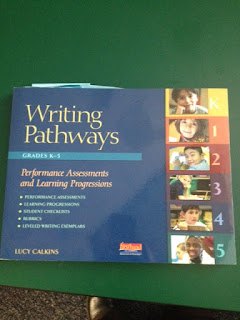I began this week's common planning time with 4th and 5th grade by asking the teachers to listen to the following quote from Kylene Beers and Robert E. Probst's new book Reading Nonfiction: Notice & Note, Stances, Signposts, and Strategies.
"When we rely on lectures and our own explanations, instead of having students read, we imply that someone else knows and all students have to do is listen. This disenfranchises them and leaves them vulnerable. It suggests they should let others tell them what to know. It doesn’t raise students who think independently...when they encounter a difficult text in their adult lives, they will again look up and say, “I don’t get it,” and wait for someone else to tell them what they should know."
The majority of their comments included: "That makes sense." From here I passed around the following survey:
I asked them to notice if they see any patterns in their answers and if there is anything they would like to change. Here are some of the responses:
- I am large, and in charge.
- This sounds like what we are trying to do with personalized learning.
- This seems like a lot of student talk, not much teacher talk.
- This goes along with our book study, Learn Like a Pirate.
Then I moved into teaching the first big question, What surprised me?
The following came from page 83 of Reading Nonfiction: Notice and Note.
“We suspect that at some point you’ve talked with a friend and heard that friend say something that you just can’t believe is true. The comment was so surprising that you find yourself saying “Really?” and you want to know more. Or you’ve been riding in a car and something catches your attention and makes you say to others, “Wow! Look at that!” You notice things that are meaningful to you. And once you notice what you found to be surprising information, that’s probably what you most want to discuss with others. And if you found nothing surprising, you would consider it a dull conversation or a boring ride.
In a similar way, an entire ball game with nothing surprising would probably leave you complaining about how dull it had been. The same is true of nonfiction we read. If we finish the text and nothing has caught our attention, nothing has made us say, “Really?” or “I didn’t know that!” then we probably think what we’ve just read was dull. If, though, as we read we notice some fact that surprises us-maybe just a little or perhaps a great deal-what we’re reading will be more meaningful.
So when you read nonfiction, you should read with that expectation of surprise. A stance that says, “I will be surprised” will help you see information as more than just facts; you will see it as information that is new to you. Remember-if you want to find a surprise, you actually must look for one. If you decide to stay alert for those passages that make you say, “Really?” we suspect you will be pleased with what you discover.
We then watched a video of 6th graders in action using this first Big Question.
Video:
http://www.heinemann.com/shared/iplayer.aspx?id=c439wjt06t&utm_medium=shorturl&utm_source=readnf2




















